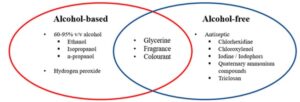What is a hand sanitizer?
- It is is a liquid, gel, or foam generally used to decrease infectious agents on the hands
- In other words, Hand sanitizer also called hand antiseptic, handrub, or hand rub, agent applied to the hands for the purpose of removing common pathogens (disease-causing organisms)
Types of hand sanitizer
Depending on the active ingredient used, hand sanitizers can be classified as two types, such as:
- Alcohol-based:
- Alcohol-based products typically contain between 60 and 95 percent alcohol, usually in the form of ethanol, isopropanol, or n-propanol.
- At those concentrations, alcohol immediately denatures proteins, effectively neutralizing certain types of microorganisms.
- Alcohol-free:
- They are generally based on disinfectants, such as benzalkonium chloride (BAC), or on antimicrobial agents, such as triclosan
- Alcohol-based:
- The activity of disinfectants and antimicrobial agents is both immediate and persistent


Effectiveness of hand sanitizer
- It depends on multiple factors, including the manner in which the product is applied (e.g., quantity used, duration of exposure, frequency of use) and
- Whether the specific infectious agents present on the person’s hands are susceptible to the active ingredient in the product.
- In general, alcohol-based hand sanitizers, if rubbed thoroughly over finger and hand surfaces for a period of 30 seconds, followed by complete air-drying, can effectively reduce populations of bacteria, fungi, and some enveloped viruses (e.g., influenza A viruses)
- Similar effects have been reported for certain alcohol-free formulations, such as SAB (surfactant, allantoin, and BAC) hand sanitizer
- Most hand sanitizers, however, are relatively ineffective against bacterial spores, nonenveloped viruses (e.g., norovirus), and encysted parasites (e.g., Giardia)
















